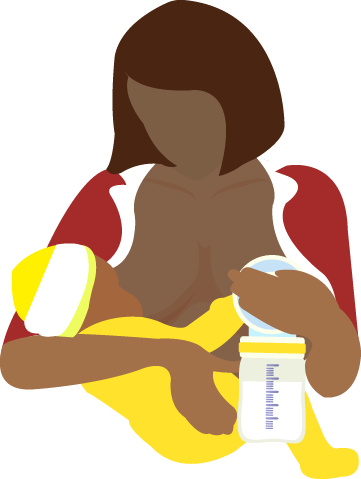A well-fed mama means a well-fed baby
You are what you eat, and that becomes extra important when baby is also eating. While you don’t have to obsess like you did when you were pregnant, a healthy postpartum diet is key to breastfeeding success. Follow these tips to start:
Drink up. Your body is working hard to make baby’s milk, that’s why it may seem like you’re thirsty all the time. Drink at least eight glasses of water a day to stave off dehydration and keep your milk flowing.
Eat a balanced diet. You’ll need three servings of protein, five servings of calcium, three servings of whole grains and five to six servings of fruits and vegetables daily (more vegetables than fruit).
Incorporate healthy fats. Load up on brain-building healthy fats, especially omega-3 fatty acids found in low-mercury fish like salmon and sardines and DHA-enriched eggs.
Don’t skip your prenatal vitamin. Keep taking it until you’re completely done breastfeeding. You can also keep taking your DHA supplement from pregnancy.
Breastfeeding should not be painful
Your breasts are your number one asset when you’re breastfeeding. But when they’re working overtime, you may hit a few roadblocks. A few common causes of breastfeeding and nipple pain include:
Mastitis. This breast inflammation is caused by an infection that gets into the breast. It causes flu-like symptoms and red irritation around the breast. Mastitis often happens when germs from baby’s mouth enter a milk duct through cracks in the nipple. You can avoid it by pumping or nursing baby to avoid engorgement. When the infection forms, breastfeeding helps to relieve it. Your doctor will also prescribe an antibiotic to clear the infection.
Blocked milk ducts. If you notice a painful spot on your breast that’s red and irritated, you may have a blocked duct. Keep breastfeeding so that your flow will eventually break through the blockage.
Sore or cracked nipples. Just because your breasts are working extra hard doesn’t mean they should be sore. Lanolin cream applied after each nursing session can help. But more importantly, adjust your breastfeeding position and make sure baby has a good latch.
Don’t get overly anxious about your milk supply
There’s nothing more stressful for new moms than worrying about whether baby is getting enough milk. It can be hard to tell whether you’re producing enough, but don’t worry. You don’t have to measure your breast milk to know for sure.
Here are some other ways to ensure your baby is well-fed:
Count diapers. Dirty diapers can tell you a lot about baby’s eating habits. She should have between six to 12 wet diapers and five yellow bowel movements each day.
Check for fussiness. If your baby is snoozing and seems content, feeding is likely not an issue. But if she’s crying and furiously sucking her fingers, she’s probably still hungry.
Have your baby checked at well visits. Your doctor will check baby’s weight at each well-baby visit and plot it out on a growth chart. Your baby will lose body weight due to fluid loss after birth, but she should gain it back within 10 to 14 days. Babies should gain around 5 to 7 ounces a week.
Leaks happen
If breastfeeding your newborn sometimes makes you feel like you’re in a wet T-shirt contest, you’re not alone. Leaky breasts are actually a beautiful thing because they show a mom’s biological need to feed baby, but that doesn’t make them any less messy.
Talking to your baby, hearing baby’s voice or even seeing a picture of your little one can start the let-down process before a feeding session. This is especially true in the beginning. If you’ve got leaky breasts, planning ahead can help:
Keep a stash of nursing pads on hand in a pinch.
If leaks are becoming an issue at night, place towels under you while you sleep so you won’t have to change your sheets in the morning.
Hide leaks better by wearing dark prints instead of solids, which will buy you some time until you get home.
Don’t pump. Leaky breasts aren’t helped by extra pumping. In fact, it just ups your supply and makes the problem worse.
Breastfeeding can be an emotional rollercoaster in the beginning, but with a little time and patience, you and your baby will likely get the hang of it. So have faith! Since it’s such a good way to nourish and bond with your little one, it’s well worth the effort.
Source: What to Expect





1 Comment
Thanks for sharing. I read many of your blog posts, cool, your blog is very good.